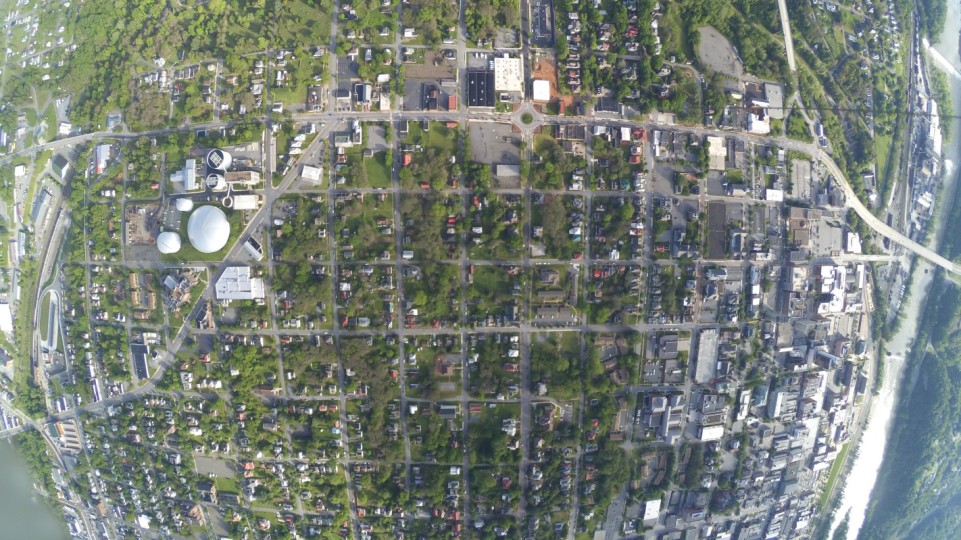AREVA NAYGN Works with High School Students on a ‘Space Balloon’ Project to Photograph the Earth from Space

Submitted by Adam Spontarelli (AREVA, Inc.)
Our goal was to take a picture of the Earth. We thought about simply enjoying existing images easily found online, but similar to the satisfaction gained from changing your own brake pads, we decided it would be more enjoyable to take the pictures ourselves. So with three NAYGN members, we recruited two teams of high schoolers for our very own mini-space race. Each team had seven students from a variety of backgrounds and local schools, and each was led by one of our engineers.
Our only guideline was that we'd use weather balloons to carry the cameras. Aside from this, the approach was open for the students to decide, and it shows, as both teams adopted wildly different strategies. Dave's team focused on simplicity and function, while Paul's team sought innovation and adventure. And while both have incredible stories to share after a combined total of 20 weeks of work, this story is but a snippet of Paul's team: No Strings Attached.

Paul and his team wanted good pictures, which meant they would need to reach high altitudes. This can be done by buying large balloons and likewise large quantities of lifting gas, but as with most things, it can also be done more efficiently, with a little bit of science and engineering. For any given balloon, there's an optimum amount of helium to fill it with. Too much and the balloon will expand rapidly, bursting at a low altitude. Too little and the balloon won't have the lift to reach its burst altitude, sending it on a journey around the world, unlikely to ever be found. The students had to understand this, and they had to make their calculations accordingly. So we spent time illuminating this concept through experiment, using a vacuum chamber to demonstrate the physics (and test our hardware). They tested their altimeter's accuracy in the chamber and added dry ice to simulate the negative 50 degree temperatures that would potentially freeze their electronics. They used it to burst balloons, confirming their predictions. They enjoyed their vacuum chamber so much that they decided to build a custom one, first from wood, then from steel after the wooden frame collapsed. But testing was only a small part of their efforts. Much of their time was spend building circuits, writing code, designing and building their capsule and its various components.
Team No Strings Attached missed their launch date, by a lot. In fact, they missed the launch window to even be considered in the official Global Space Balloon competition. Regardless, after 10 weeks, they were ready to launch. The plan was to meet Sunday morning and launch at 8am, which would put the capsule near Farmville around 11am according to their predictions.

So they met, and the team began assembling their capsule. The first test of the flight controller made clear that not everything was actually ready. For some reason, the relays were opening when expected to close. Apparently the wrong version of the code was uploaded to the board. After sorting through a vast collection of different Arduino sketches, the right one was finally found. The rest of the parts were collected and they made their way to the launch site close to 9am, after which things only got worse.
The staging area was set; they began filling the balloon with 125 cubic feet of helium, while others started assembling the capsule. One of the cameras wasn't working, most likely a dead battery, and another camera was missing an SD card, so they salvaged the one in the dead camera. Camera down, they installed the main flight unit into the capsule and turned on the GPS trackers to find that the transmitter was not working. They rebooted it a few times and finally took an auxiliary SD card from it that seemed to be causing problems. They'd have to live without the altitude data.
Once everything was finally in place, it was time to connect the main battery. The loud explosion that followed came as a surprise to the spectators who had formed an hour earlier, but was somewhat expected by the team. They admirably designed a ballistic parachute that worked well in testing, but they had this problem before when the Arduino starts up and sends a spurious signal to ignite the black powder. The way around it was to power the Arduino first, let it boot, then plug in the ballistic charge, but they got it backwards. Knowing that the chute wasn't going to release on its own, they moved it at the last minute and hung it outside the capsule. At this point, stress was high and it was time to let the capsule on its journey, regardless of the problems faced so far. The countdown began. The inflated balloon floated 20 feet above us, tethered to the capsule by a string. And when the countdown reached 4, that string broke, and off went the balloon with all of its helium, while the team stood there, dejected, capsule still in hand.

They met back at Vector Space, stood around a table, and shared their thoughts. It was no surprise that everyone was disappointed, but what was unexpected was the way the students handled it. Instead of sulking and parting ways, they made a plan. They would meet tomorrow night, then again on Wednesday, and the following week to fix what went wrong. It was clear they were serious this time, and the determination persisted through the next two weeks, preparing them for a second launch which proved significantly more successful.

Their capsule ended up reaching 116,000 feet before returning back to Earth and landing in Lexington. Though they succeeded in the end, No Strings Attached experienced a phrase often heard at Vector Space: failure IS an option. We hope they won't forget it.
Video: https://youtu.be/Sujng8vTRlA?list=PLULLVDVuRvsL_2MwbKvyTa1VpZNwZ63LZ
Further reading:
http://www.newsadvance.com/work_it_lynchburg/news/lynchburg-to-soon-get-make-your-own-space/article_8e95cec3-8632-52be-b06d-aa3ee8a6bcc7.html
http://www.lynchburgliving.com/discover-create-collaborate-citys-first-makerspace/




